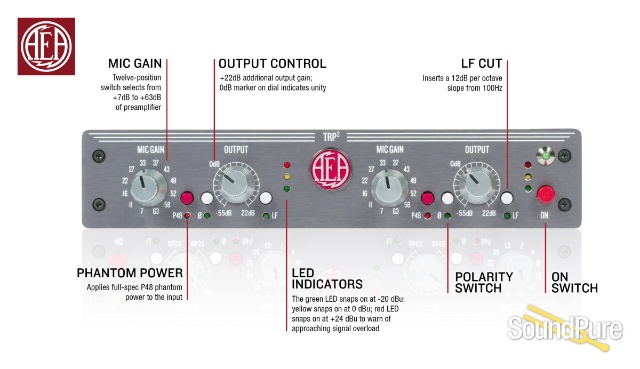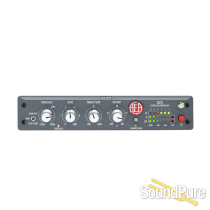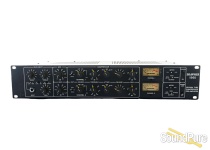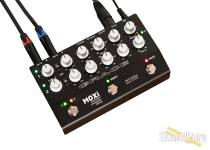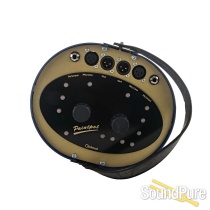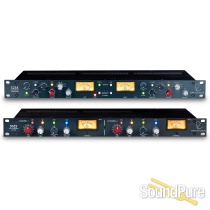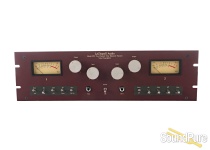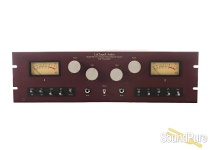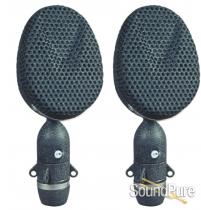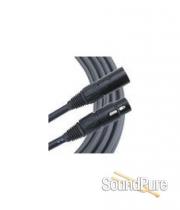-
Call Us Toll Free888-528-9703
-
Local/International (+1)919-682-5552
- Call Us! Toll Free! 888-528-9703
- Local / International (+1) 919-682-5552

AEA TRP2 Stereo Ribbon Microphone Preamp From AEA
The new and improved, compact, 1/2 rack space Stereo Ribbon Microphone Preamp designed to highlight the sounds of your ribbon with plenty of gain and high impedance. Now with phantom power to bring out the best in your ACTIVE ribbons and any condenser as well
What We Think
The TRP2 expands up an already truly excellent box for anyone who wants to make an investment in ribbon microphones, and wants the absolute cleanest signal path ever designed for ribbons in mind. This incredible preamp was designed by genius engineer, Fred Forssell, who has secretly and not-so-secretly been involved in the design and creation of some of the finest preamp designs in modern recording history. This truly unique approach to ribbon microphone pre-amplification has generated this a lean, mean, and clean ribbon-microphone machine.
Now with the popularity and impressive sound/adaptation of active ribbon mic circuitry, AEA has added phantom power to both channels to give the best results to both ribbon and condensers
This is a very straightforward compact stereo pre the gives you clear results and stays out of the way!
Manufacturer's Description from AEA
ENHANCE YOUR RIBBONS
The AEA TRP2 Ribbon Preamp provides two channels of high-output, high-impedance, and low-noise gain with a rich and natural sound that brings out the full potential of your microphones. Specifically designed for ribbon microphones, the TRP2 excels at drawing out the warmth and lush sound that ribbons are uniquely known for.
A GAIN POWERHOUSE
The TRP2 is a powerhouse that provides unparalleled high gain with low-noise. With 85db of JFET output, the TRP2 gives you enough juice to record soft sources without ever having to worry about noise. With the TRP2, you will never consider a source too quiet to record with a ribbon mic ever again. Passive ribbons with low output levels require preamps that supply a high level of output. If the preamp you use doesn’t have enough clean gain, the mic signal may seem too soft or noisy which may be apparent when recording quiet acoustic guitars or strings, especially at a distance or with long cable runs. The TRP2 eliminates this concern.
PROFESSIONAL FEATURES IN A COMPACT PACKAGE
The TRP2 is AEA’s second iteration of the high-performance TRP preamp with the addition of new features including phantom power, optional rack ears, and a switching power supply.Polarity reverse switches for ensuring proper polarity throughout the recording chain and switchable 100 Hz, 12 dB per octave low-frequency filters allow you to tame proximity problems. The TRP2 includes switchable phantom power that is capable of powering condensers and active ribbons. For engineers concerned about phantom power hurting their passive ribbons, there is phantom power kill switch, known as No Blow Mode, located internally within the unit that easily deactivates 48V from ever turning on.
HIGH IMPEDANCE MAKES A HUGE DIFFERENCE
The sound and tonality of dynamic microphones like ribbons and moving-coils are directly affected by the impedance of a preamp. The higher the impedance, the better the sound. The RPQ2 boasts an extra high input impedance of 63K Ohms. Preamps with an impedance of under 10k ohms will limit the lows, highs, and transients of your passive microphones. The RPQ2’s high impedance will reveal your microphone’s true nature– a thick low-end, open top-end, and articulate transient response that you will need to hear to believe. Both condensers and active microphones will also benefit from the RPQ2’s impedance.
A UNIVERSAL POWER SUPPLY
An external switching power supply with a grounded AC plug is used with the TRP2 so hum fields can be kept away from the high-gain electronics. The power supply allows the TRP2 to be used in any country without any modifications made to the unit.
OPTIONS TO RACK THE TRP
The TRP2 is housed in a portable and lightweight half-rack aluminum chassis. This form factor allows you to easily take it to remote gigs, other studios, and on the road. The TRP2 can be easily racked with the optional TRP2 Rack Ears. Attach the rack ears to the TRP2 and unit can be securely installed in any standard rack. Two TRP2s can be mounted side by side in a single rack space by purchasing the AEA TRP2 Rack Shelf. Screwing two TRP2s to the rack shelf, the whole assembly can be securely installed in any standard rack.
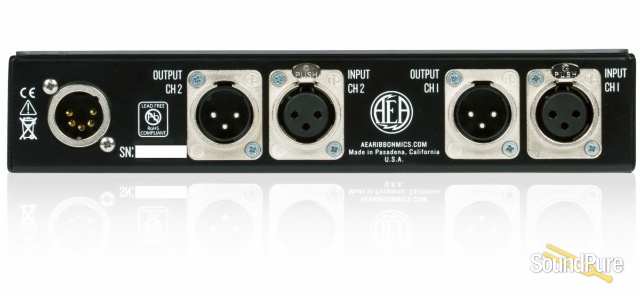
About Manufacturer
Wes Dooley's longtime passion for audio has infused his company, Audio Engineering Associates (AEA), with a well balanced blend of creativity and technical expertise for forty years. At the core of AEA is a genuine interest in the art and science of audio. From areas as diverse as forensic audio and microphone design, Wes' passion for audio has led him all over the world, from recording experiences in Europe, Africa, and New Zealand, to the courtrooms of Los Angeles as a forensic audio and video expert witness. Such experiences have led Wes to design products which help resolve problems commonly encountered by recording engineers. His portable recording tools including, multi-channel microphone arrays, MS stereo processors, stereo phase displays and very tall microphone stands, have all made on-site recording far more feasible. Despite his contributions to on-location recording, Wes is best known for his pursuit of excellence in ribbon microphone technology. After two decades of representing and servicing the BBC 4038 in the United States, he began to experiment with his own ribbon microphones. During the last decade Wes became aware of the increasing scarcity of R44's and other ribbon microphones. In 1998, responding to this need, Wes re-introduced the 44 much to the thrill of many in the recording industry. Les Paul told Wes that AEA's R44 is his favorite microphone and engineer/producers such as Bruce Swedien, Kevin Bacon, and Shawn Murphy routinely use AEA's R44. Even without such critical acclaim the numbers speak for themselves. Over half of the movies scored in Los Angeles have a 44 somewhere on the scoring stage. Building off of his successful reintroduction of the R44, in 2002 Wes designed and began producing an original ribbon mic, the AEA R84. His groundbreaking work with ribbon microphones helped him to secure the Audio Engineering Society (AES) Silver Medal Award in the fall of 2003. This award, established by the AES in 1971, in honor of audio pioneers Alexander Graham Bell, Emile Berliner, and Thomas A. Edison, is given in recognition of outstanding development or achievement in the field of audio engineering. Wes has also co-authored two AES Journal articles about stereo microphone techniques, chaired workshops on mic techniques and mixing strategies for compatible multiple releases for cinema, broadcast and home video, and has presented section meetings on stereo techniques and forensic audio. He is involved with AES standards work and currently serves on the SC-03-12 Working Group on Forensic Audio and SC-04-04 Working Group on Microphone Measurement and Characterization.
Specifications
Gain at 1kHz: 85dB of gain at 1kHz, balanced-in to balanced-out in Microphone Input mode
Noise figure, rms A-weighted: <2dB
Noise figure, rms unweighted: <3dB, 20 kHz LPF bandwidth
EIN: <-130 dBu A-weighted, 150 Ohm resistive source
THD: -3dB <1Hz and >100 kHz <0.02% at 1 kHz
Input impedance: 63K Ohms (10K Ohms when P48 is engaged)
Input Gain control: Twelve-position switch provides from +7dB to +63dB of gain for the preamplifier circuit, as measured between the input and the before the output line driver.
Switched LF Shelving filter: 12dB per octave from 100 Hz
Color LEDs: Yellow, Green, Red
XLR output maximum level into 600Ω load: +28 dBu, balanced; 0 dBu = 0.7746 V rms
XLR connectors polarity: Pin-1 is ground, pin-2 is high, pin-3 is low
LED signal level indicators: The green LED snaps on at -20 dBu to indicate the presence of signal; the yellow LED snaps on at 0 dBu; the red LED snaps on at +24 dBu to warn of approaching signal overload.
External Features:
An external switching power supply with a grounded AC plug is used with the TRP2 so hum fields can be kept away from the high-gain electronics. The power supply allows the TRP2 to be used in any country without any modifications made to the unit. The power supply uses a 5-pin XLR connector for its output. It has one 18 volt AC secondary winding, which is used within the TRP2 to provide three regulated DC voltages. Bi-polar 18-volt rails are provided for the electronics and a +12 volt rail for the Aeromat relays.
Dimensions
Size: 8.5” w, 8.5 d, 1.5” h (36.7 cm x 36.7 cm x 4.3 cm)
Weight: 2lbs oz (0.9 kg)
